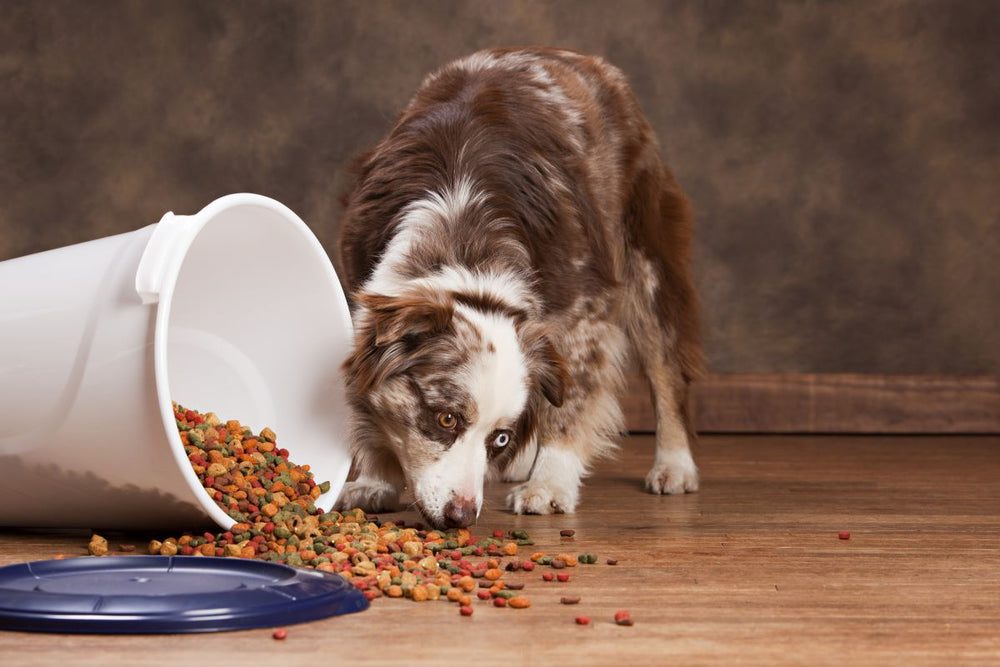By: Kayla Kowalski, Certified Canine Nutritionist
While some dogs may nibble their kibble, others channel their canine ancestors as they wolf down their food. This can make for an amusing mealtime scene, but fast eating can indicate and lead to severe medical conditions, some of which have life-threatening consequences.
Helping your pup slow down their eating can reduce gastrointestinal upset, aid in weight management, and be a valuable component of healthy eating habits.
What Happens If a Dog Eats Too Fast?
Dogs that scarf down their meals tend to vomit their food back up. And, let's be honest, it's never fun cleaning up undigested food, not to mention watching your dog trying to help with the cleanup. However, there can be many other risks for speedy eaters. Some, like bloating and excessive gas, may seem harmless, but others can be scary.
Some severe side-effects of speed eating include:
- gagging or choking
- vomiting
- diarrhea
- gastric dilatation volvulus (GDV)
Fast eaters are also prone to overeating, which can lead to weight gain. When a dog eats too fast, their overall satiety or satisfaction from their meal decreases. This can lead to more begging and stealing, which, in turn, leads to increased calorie intake, causing, you guessed it, weight gain.

How to Help Your Dog Eat Slower
Pre-Measure Your Dog's Meals
To prevent over-feeding, try measuring your pup's food for the whole day at once and feeding them only from this allotment throughout the day. This way, even if your dog gets food outside their regular feeding schedule, it'll still be within their preset amount of food for the day.
This may help avoid accidental "second breakfasts" or overindulging when you give in to those irresistible puppy dog eyes at lunchtime. You can also use this stash of kibble as a reward for any training sessions you have throughout the day.
Make Mealtime More Mentally Stimulating
Turning breakfast or dinner into an interactive activity is a great way to slow your pup's eating while boosting mental stimulation. Kongs, puzzle feeders, lick mats, and snuffle mats are all excellent options, depending on your dog's preferences and whether they are eating kibble or wet food.
Get Creative in the Kitchen
If you want to try a DIY route to help your pup slow their roll, there are some fun and creative options using equipment you likely already have around the house. We recommend mixing and matching these techniques to keep your pup engaged.
You can use a muffin tin or cardboard egg carton and place a few treats or pieces of kibble into each compartment, making it harder for your pup to inhale all their food in one big gulp.
Add some dry food or treats into a rolled-up towel and tie the towel in a knot. Your pup must tug their way into the towel to get at the yummy goodness inside.
Lastly, you can also try freezing your dog's food to give them something to lick at and gnaw on as their food defrosts slowly over time.

The Classic Option: A Slow-Feeder Dog Bowl
Eating too fast is such a common concern for pet parents that you can buy premade dog bowls explicitly designed for speed eaters. While the previous suggestions require more ingenuity, a slow feeder bowl is a great low-maintenance option. Here's what to look for when choosing a slow feeder bowl:
- appropriate challenge level
- the right size bowl
- dog- and food-safe materials
Part of keeping mealtime engaging is also keeping mealtime fun! Ensuring your slow feeder bowl and other food puzzles present a realistic challenge to your pup - and don't overwhelm them - will also help them maintain a healthy relationship with their food.
Dogs come in all shapes and sizes, so it's natural to pick a dog bowl that comes in an appropriate size for your unique pup. We are not only talking about larger vs. smaller portions, but that, for example, a puzzle feeder for a dog with a large snout would not present much of a challenge to a small-snouted puppy.
Lastly, as with all food bowls, choosing an option made from food- and pet-safe materials is essential. Plastic bowls should be BPA- and phthalate-free; ceramic bowls should be made with lead-free glaze and regularly inspected for chips or cracks; and stainless steel bowls should always be indicated as food safe.

The Low-Down on the Slow-Down
Speed eating can be a serious concern for dog owners who want their pups to enjoy (and digest) their food. Dogs that eat too fast are prone to gastrointestinal upset, such as vomiting, diarrhea, bloating, and even more severe health issues.
To help your dog eat slower and prevent overeating, we recommend using a slow-feeder dog bowl or implementing one or more DIY techniques to increase your pup's mental engagement at mealtime. Slower eating will lead to increased satiety, reduced likelihood of weight gain, and (best of all) less mess for pet parents to clean up.
If your dog eats too fast, try these techniques, and your speedy eater will be quick to thank you for helping them enjoy mealtime even more!
Kayla Kowalski is a Certified Canine Nutritionist (CertCN) who has guided over 4,000 pet parents through custom diet transitions. To learn more about improving your dog's health and diet, whether they are fast eaters or not, visit KaylaKowalski.com.


